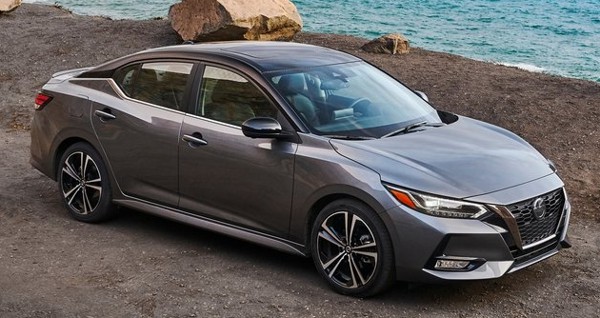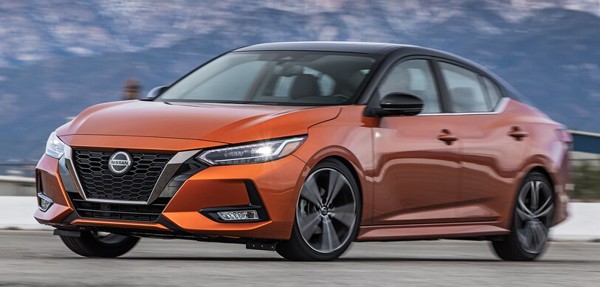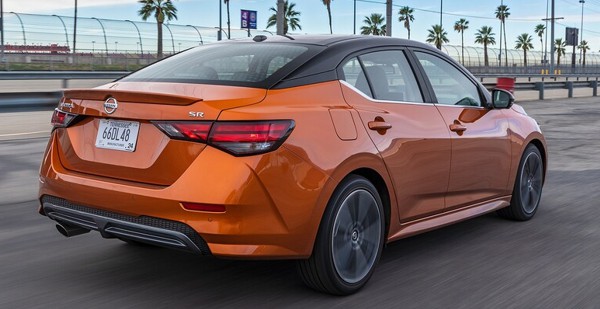Published
on 20
Feb 2020
|
All rights reserved.
|
|
|

|
|
A
striking new look may help an average car to score more than average
sales.
|
|
The last generation Sentra
and Sylphy, as called in North America and China, respectively, was one
of the very few cars that earned 1-star junk rating. Dull-looking
inside and outside, boring to drive, slow and unrefined, it trailed
just about every other compact cars on the market. However, the car was
spacious and cheap, satisfying the basic demand for average buyers who
take cars like appliances, so it still registered more than 200,000
sales annually in the USA and north of 300,000 units in China,
surprisingly. If it gets a more striking design, better finishing and
driving dynamics, will it beat sales leaders like Honda Civic and
Toyota Corolla?
The new generation Sentra and Sylphy is a good looker. In contrast to
the old car, it looks stylish and very sporty. The “V-motion 2.0”
grille leads a sleek body shape. Sharp crease lines and a floating roof
add aggression. Use a tape to measure, you will find the new body has a
sporty profile. It is very wide at 1815 mm, but relatively low at 1447
mm. The 2712 mm wheelbase is the longest in class, while the 4641 mm
length is not far away. All these dimensions allow the designers to do
whatever they desired. Moreover, a sleeker shape benefits aerodynamics.
Its drag coefficient is a remarkable 0.26, no doubt helping fuel
economy.

|
|
The
Sentra/Sylphy looks like a 4-door coupe, but it doesn't drive like.
|
|
Inside, the surprise continues. It looks stylish, thanks to the shapely
dashboard architecture, turbine-like air vents, satin chrome accents,
leatherette dash top and quilted leather seats. An 8-inch touchscreen
stands above the slim center console for easy reading and touching. A
leather-wrapped, flat-bottom steering wheel incorporates audio, trip
computer, bluetooth phone and voice control. It looks premium enough,
although touching the surfaces will find it is actually not that soft.
Build quality and attention to details are certainly no match for
Volkswagen Golf or Peugeot 308, but it is decent for the class.
As expected, space is abundant. The driver seat is mounted lower than
the old car for a sportier driving position and offsetting the lower
roof. Nissan’s “zero gravity” seats are comfortable for long journeys.
At the back, there is generous legroom and hip room, although
six-footers will find headroom marginal. In-cabin storage is aplenty.
The boot is big. 60/40-split folding rear seat is standard on the
American Sentra but strangely omitted in the Chinese Sylphy.

|
|
Interior is
spacious and premium-looking.
|
|
While the old car was built on V-platform, the new car sits on the
larger CMF-C/D platform that underpins also Nissan Qashqai, Renault
Megane and Espace, to name a few. The Sylphy rides on conventional
MacPherson strut suspension up front, and a simple torsion-beam axle
serves the rear wheels. Surprisingly, perhaps in response to Honda
Civic and Toyota Corolla, the American version opts for a multi-link
arrangement at the rear regardless of trims. Both cars have their
electric power steering upgraded to a dual-pinion design like
Volkswagen, which should offer more feel. Otherwise, there is not much
to write about.
Under the bonnet, the Sylphy employs a Gen3 HR16DE engine, which is
1.6-liter and naturally aspirated. It is rather low-tech by today’s
standard, lacking direct injection, mild-hybrid or cylinder
deactivation as the Chinese government does not push car makers to cut
emission as hard as Europe. Nissan claims the combination of electric
CVVT, exhaust gas recirculation, spray-coated cylinder bore and a
higher compression ratio good enough to generate 139 horsepower and 125
lbft of torque. I think it is a little doubtful, as the American
version of this engine on Versa produces only 122 hp and 114 lbft.
Anyway, mating with a CVT exclusively, the Sylphy manages 0-60 in an
unremarkable 10.8 seconds.
The American Sentra gets more power, of course. Its engine is MR20DD, a
2-liter direct injection with CVVT. Being also an aging design, it
produces 149 hp and 146 lbft of torque, trailing the turbocharged
engines of its rivals as well as the naturally aspirated engines from
Toyota and Mazda. Again it is mated to an Xtronic CVT. Performance is a
bit better, with 0-60 done in about 9 seconds, but still too slow for
the class.
 |
|
The lack of
power hurts refinement...
|
|
The lack of power also hurts refinement. When accelerate in urgency
from a stop, the Xtronic CVT tends to drone the engine, generating a
lot of noise. Likewise, overtaking on the fast lane at 70 mph will find
both engines screaming crazily. The 1.5 turbo engine of Honda Civic
just won’t behave that badly, since it has sufficient mid-range torque
to keep the engine from reaching the upper rev range. If you want to
use the Xtronic’s manual override to avoid droning, you will find the
lack of paddle shifters makes this inconvenient, and the long delay of
its artificial shift annoying. Volkswagen’s DSG and Ford Focus’ 8-speed
automatic are better options.
Despite a sporty look, the Sylphy has a chassis tuned for comfort in
the first place. It rides softly and steers effortlessly. Rolls a lot
and its rear axle fails to keep up with the front. In short, it is fine
for daily commute, but never encourage a spirited drive. The Sentra is
better with its independent rear suspension, stiffer suspension tuning,
quicker and heftier steering program. It steers more accurately and
corners with less float. But still, not to be called fun to drive. The
steering is still short of feel. The ride is too firm, lacking the
controlled yet absorbent manner of a number of rivals. The 18-inch
Hankook tires generate quite a lot of noise. In addition to the wind
noise coming from the A-pillars at motorway speed, the Sentra delivers
neither driver appeal nor refinement. In the end, what leaves you is a
good-looking packaging – striking outside, premium inside, but no
substances in between.
Still, the average buyers are usually skin-deep. Last year, 460,000
Sylphys were sold in China, ranked number 2 in passenger car sales
chart. There is no reason why Sentra cannot repeat the same success in
the USA.
|
Verdict:    |
|